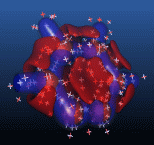|
|
Genetics Test 3
|
|
|
Genetics *including answer
|
PART A: MULTIPLE CHOICE
1
. Which if the following are found in DNA?
a
. ribose, phosphate, A, T, G, C
b
. ribose, phosphate, A, T, G, C, U
c
. deoxyribose, phosphate, A, T, G, C
d
. deoxyribose, phosphate, A, T, G, U
e
. none of the above.
2
.
Which if the following are found in DNA?
a
. deoxyribose, phosphate, A, T, G, U
b
. ribose, phosphate, A, T, G, C, U
c
. ribose, phosphate, A, T, G, C
d
. deoxyribose, phosphate, A, T, G, C
e
. none of the above.
3
.
An allele is:
a
. a gene
b
. a trait
c
. a form of a gene
d
. a form of a trait
e
. a slippery animal served in ethnic restaurants
4
.
Which molecules are used in translation?
a
. tRNA, mRNA, endonuclease
b
. tRNA, mRNA, DNA, ribosomes
c
. ligase, mRNA, DNA, ribosomes
d
. tRNA, RNA polymerase, DNA, ribosomes
5
.
A certain population contains 20% A, 50% B of the ABO
alleles. What would the
percentage of O allele be?
a
. 0%
b
. 1%
c
. 9%
d
. 10%
e
. 30%
6
.
A certain population contains 20% A, 50% B of the ABO
alleles. What would the
percentage of O blood type be?
a
. 0%
b
. 1%
c
. 9%
d
. 10%
e
. 30%
7
.
How many (alleles) are there for eye colour?
a
. 1
b
. 2
c
. 3
d
. more than 3
8
.
Which phage was studied when overlapping genes were
discovered?
a
. φX174
b
. T4
c
. pBR322
d
. T2
e
. RNE
9
.
Introns are:
a
. areas of RNA which are expressed
b
. areas of RNA which are not expressed
c
. areas of DNA which are expressed
d
. areas of DNA which are not expressed
10
.
Histones are:
a
. found attached to DNA
b
. used to wrap DNA
c
. both of the above
11
.
Translation is:
a
. conversion of mRNA to polypeptides
b
. reading of mRNA to make polypeptides
c
. conversion of DNA to RNA
d
. reading of DNA to make mRNA
12
.
Transcription is:
a
. conversion of DNA to RNA
b
. reading of DNA to make mRNA
c
. conversion of mRNA to polypeptides
d
. reading of mRNA to make polypeptides
13
.
The least important codon is the:
a
. first - regardless of whether it's A,T,G or C
b
. second - regardless of whether it's A,T,G or C
c
. third - regardless of whether it's A,T,G or C
d
. T - always
e
. U - always
PART B: SHORT ANSWER
1
.
State the differences between the structure of DNA and
RNA.
2
. How many different base sequences could arise from a gene
fragment 20 base pairs in length?
3
. Phenylketonuria involves a single mutation of amino acid
number 138 - a switch from alanine to proline. What was (or were) the original codon(s), and what is the
mutated codon(s) likely?
4
. Show the polypeptide for the gene fragment -AUGGACCGUUGAAUU-.
5
. Using the fragment -AUGGACCGUUGAAUU-, do a mutation which
would result in premature termination of the peptide. PART C: ANSWERS YOU CAN PROUD OF
(hopefully)
1
. A certain recessive trait exhibits Mendellian
dominant-recessive characteristics.
One in 100 exhibit the trait.
a
. Show the Punnet square using the ratios (proportions) of
the two alleles.
b
. In Canada, (popl 27 000 000) how many carriers are there?
2
.
Describe the process of DNA replication. Include the concept
of 5'3', DNA polymerase, ligase, unwindase, and Okazaki fragments.
Use diagrams.
3
. The mitochondrial genome of Saccharomyces Cerevisae
(yeast) contains 84,000 base pairs.
It makes 9 proteins. There
are only two initiation sites reading left to right, and only one
initiation site reading right to left.
What strategy is being employed?
4
. A phage makes proteins which requires 450 bases each.
It makes 6 different proteins.
What can you say about the genome?
5
. A gene sequence is:
-----CGUAAUGCCAAAAGGUAAGUAA----
a
. How many polypeptides could this gene
"theoretically" make? Explain.
6
.
Describe the process of recombinant DNA. Use the example of cloning the human oxytocin gene. |
